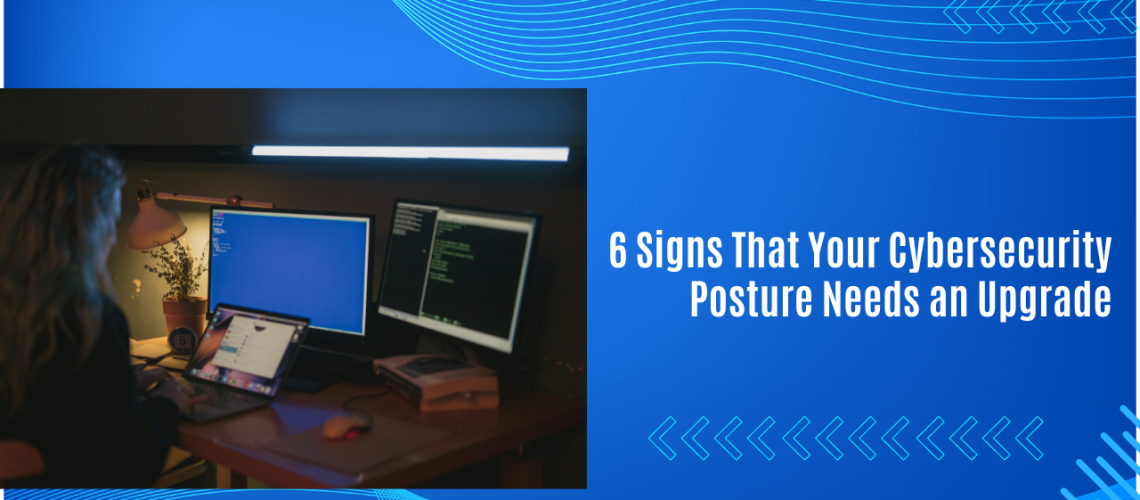In an era dominated by digital advancements, the importance of a robust cybersecurity posture cannot be overstated. As technology evolves, so do the tactics employed by cybercriminals. Organizations must stay ahead of the curve and continuously upgrade their cybersecurity measures to safeguard sensitive data and maintain the trust of their stakeholders. In this blog, we’ll explore six telltale signs that indicate your cybersecurity posture may need an upgrade.
1. Outdated Software and Systems:
One of the most glaring signs that your cybersecurity posture needs attention is the use of outdated software and systems. Legacy systems often lack the latest security patches and updates, making them vulnerable to a variety of cyber threats. Cybercriminals actively exploit vulnerabilities in outdated software, making it essential for organizations to regularly update their systems and retire obsolete technologies.
Upgrading software addresses security concerns and enhances overall system performance and functionality. Employing automated patch management tools can streamline the process of keeping software up to date, reducing the window of opportunity for cyber threats to exploit weaknesses.
2. Increasing Incidents of Phishing Attacks:
Phishing attacks continue to be a prevalent and evolving threat in the cybersecurity landscape. If your organization is experiencing a surge in phishing incidents, it’s a clear indicator that your current defenses may be inadequate. Phishing attacks often involve the use of deceptive emails or messages to trick users into revealing sensitive information or downloading malicious content.
Upgrading your cybersecurity posture involves implementing advanced email filtering solutions, conducting regular phishing awareness training for employees, and deploying multi-factor authentication (MFA) to add an extra layer of security. By staying ahead of phishing trends, organizations can significantly reduce the risk of falling victim to these deceptive tactics.
3. Inadequate Employee Training and Awareness:
Human error remains a significant factor in cybersecurity breaches. If your employees lack sufficient training and awareness regarding cybersecurity best practices, it’s time for an upgrade. A well-informed workforce is a critical line of defense against cyber threats.
Investing in comprehensive cybersecurity training programs, conducting simulated phishing exercises, and fostering a culture of cybersecurity awareness can empower employees to recognize and respond to potential threats. Regular updates and refresher courses ensure that employees stay informed about the latest cyber threats and mitigation strategies.
Also Read: 7 Cybersecurity Steps Every SMB Should Take
4. Insufficient Data Encryption:
As data becomes a more valuable commodity, the need for robust encryption measures becomes increasingly vital. If your organization does not have a comprehensive data encryption strategy in place, it’s a sign that your cybersecurity posture needs enhancement. Encryption protects sensitive information by converting it into unreadable code, making it challenging for unauthorized users to access or decipher.
Upgrade your cybersecurity measures by implementing end-to-end encryption for communication channels, encrypting sensitive data at rest, and adopting secure protocols for data transmission. This ensures that even if a cyber threat gains access to the data, it remains unintelligible without the proper decryption key.
5. Lack of Incident Response Plan:
In the face of a cyberattack, a well-defined incident response plan can distinguish between containment and widespread damage. If your organization lacks a comprehensive incident response plan or if the existing plan is outdated, it’s a clear signal that your cybersecurity posture needs attention.
An effective incident response plan should include clear protocols for identifying, containing, eradicating, recovering from, and reporting cybersecurity incidents. Regularly testing and updating the incident response plan ensures its effectiveness when a real threat arises. Training key personnel to execute the plan efficiently is equally crucial.
Also Read: What is an email secure server and what are its advantages?
6. Absence of Regular Security Audits:
Regular security audits are an essential component of a proactive cybersecurity strategy. If your organization is not conducting regular audits to assess vulnerabilities and identify potential weaknesses, it’s a sign that your cybersecurity posture may be falling behind.
Schedule periodic security audits to evaluate the effectiveness of existing security measures, identify areas for improvement, and ensure compliance with industry standards and regulations. These audits may include vulnerability assessments, penetration testing, and compliance checks. The insights from audits inform strategic decisions for upgrading and maintaining a resilient cybersecurity posture.
In conclusion, a proactive and adaptive approach to cybersecurity is essential in the ever-evolving digital landscape. Recognizing these signs and taking decisive action to upgrade your cybersecurity posture can mitigate risks, safeguard sensitive data, and fortify your organization against the evolving threat landscape. By staying ahead of cyber threats, you not only protect your organization but also demonstrate a commitment to maintaining the trust of your stakeholders in an increasingly interconnected world.



